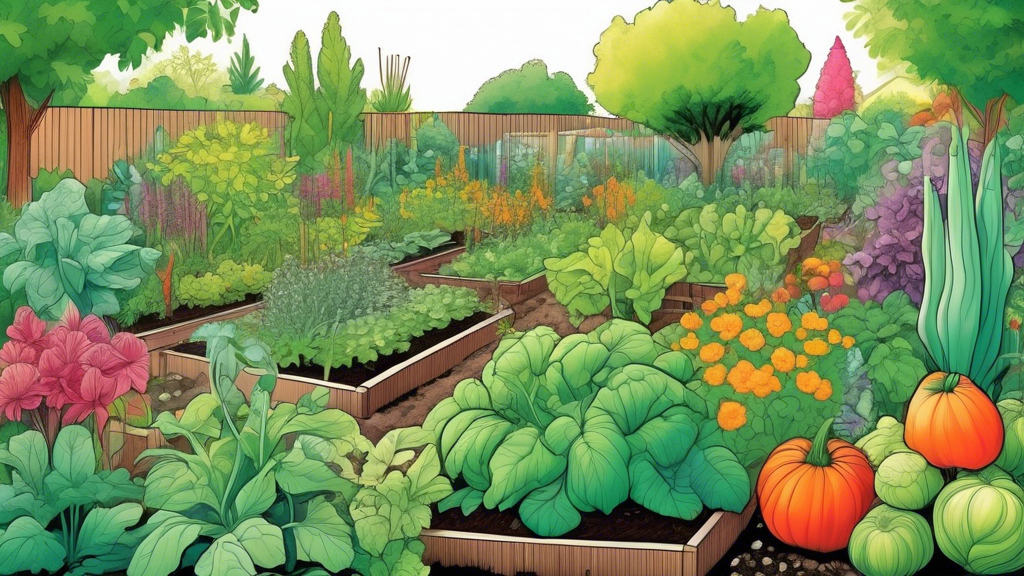Best Companion Planting Combinations for Vegetables
Introduction
Companion planting, simply put, is the art and science of growing different plants together to their mutual benefit. This gardening technique, rooted in traditional wisdom and increasingly backed by scientific research, offers numerous advantages, from maximizing space and resources to boosting yields and naturally deterring pests. By understanding the relationships between different plants, you can create a thriving, biodiverse garden that mimics the intricate ecosystems found in nature.
Understanding the Principles of Companion Planting
Before delving into specific companion planting combinations, it’s essential to grasp the underlying principles that make this method so effective:
- Pest Control: Certain plants emit strong scents or contain compounds that naturally repel harmful insects, acting as a natural deterrent for their companion plants. For example, pungent herbs like rosemary and marigolds are known to deter a wide range of pests.
- Disease Suppression: Some plant pairings can inhibit the growth of soilborne diseases. For instance, planting garlic near tomatoes can help prevent fungal diseases that commonly affect tomato plants.
- Nutrient Cycling: Legumes, a group that includes beans and peas, have the remarkable ability to fix nitrogen from the air into the soil. This fixed nitrogen benefits nearby plants, reducing the need for synthetic fertilizers.
- Pollinator Attraction: Planting flowers alongside vegetables can attract beneficial insects like bees and butterflies, crucial for pollination and, consequently, improved fruit set.
- Improved Growth and Yield: Some plants act as natural growth promoters for their neighbors. For example, chamomile is believed to enhance the flavor of herbs and vegetables growing nearby.
- Space Optimization: By intercropping plants with different growth habits, such as combining shallow-rooted lettuce with deep-rooted tomatoes, you can maximize space utilization in your garden.
Best Companion Planting Combinations for Common Vegetables:
Let’s explore some of the most effective companion planting combinations for maximizing the health and productivity of your vegetable garden:
1. Tomatoes
Tomatoes, the quintessential garden staple, can benefit from a variety of companion plants:
- Basil: Basil, with its intoxicating aroma, not only repels tomato hornworms, whiteflies, and aphids but is also believed to improve the flavor of tomatoes.
- Garlic: Garlic acts as a natural fungicide, deterring fungal diseases that commonly plague tomatoes.
- Marigolds: Marigolds are renowned for their pest-repelling properties, effectively deterring nematodes, whiteflies, and other common garden pests.
- Onions: Onions deter aphids and spider mites, while also improving the growth and flavor of tomatoes.
- Carrots: Carrots, with their deep roots, help break up the soil, improving drainage and aeration for the tomato plants.
2. Peppers
Similar to tomatoes, peppers thrive when planted alongside companion plants that deter pests and enhance growth:
- Basil: Basil repels aphids, spider mites, and other pests that can plague pepper plants.
- Onions: Onions deter aphids, carrot root flies, and other common garden pests.
- Garlic: Garlic acts as a natural fungicide, protecting pepper plants from fungal diseases.
- Marigolds: Marigolds are a versatile pest repellent, deterring nematodes, whiteflies, and other harmful insects.
3. Cucumbers
Cucumbers, known for their refreshing taste and versatility in the kitchen, can also benefit from strategic companion planting:
- Dill: Dill attracts beneficial insects like ladybugs and lacewings, which prey on aphids and other cucumber pests.
- Nasturtiums: Nasturtiums act as a trap crop, luring aphids away from cucumber plants.
- Oregano: Oregano repels cucumber beetles, a common pest that can devastate cucumber plants.
- Radishes: Radishes repel cucumber beetles and other pests, while also improving the growth and yield of cucumbers.
4. Lettuce
Lettuce, a staple in salads and sandwiches, grows well with companions that provide shade and deter pests:
- Carrots: Carrots, with their taller growth habit, provide some shade for lettuce, which prefers cooler temperatures.
- Radishes: Radishes deter aphids and other pests that can damage lettuce leaves.
- Chives: Chives repel aphids and other pests, while also improving the flavor of lettuce.
5. Carrots
Carrots, with their sweet, crunchy roots, thrive when planted alongside companions that enhance growth and deter pests:
- Onions: Onions deter carrot root flies, a common pest that can damage carrot roots.
- Rosemary: Rosemary repels carrot root flies, aphids, and other pests.
- Sage: Sage repels carrot root flies, cabbage moths, and other pests.
Plants to Avoid Planting Together
While numerous plant combinations offer mutual benefits, some pairings can be detrimental. Here are a few combinations to avoid:
- Tomatoes and Potatoes: Both members of the nightshade family, tomatoes and potatoes are susceptible to similar diseases, such as blight, and planting them together can increase the risk of disease spread.
- Fennel and Most Vegetables: Fennel, with its allelopathic properties, releases compounds that inhibit the growth of many plants. It’s best to plant fennel away from other vegetables.
- Beans and Onions/Garlic: Onions and garlic can inhibit the growth of beans. It’s best to keep these plants separated in your garden.
Conclusion
Companion planting is a testament to the interconnectedness of nature. By understanding the relationships between different plants, you can create a thriving garden that mimics the biodiversity and resilience of natural ecosystems. By implementing these companion planting strategies, you can cultivate a healthy and productive garden while fostering a deeper appreciation for the intricate web of life that sustains us all. Remember to experiment, observe, and adapt your companion planting strategies to suit your specific garden conditions and plant varieties. With practice and patience, you’ll be well on your way to a thriving and abundant garden.


